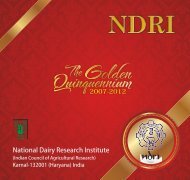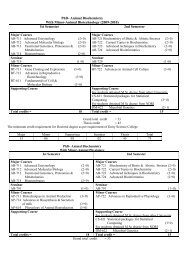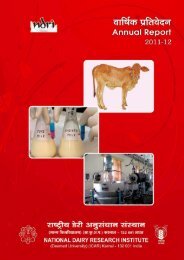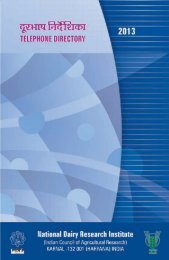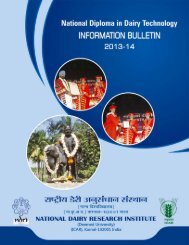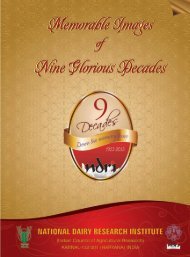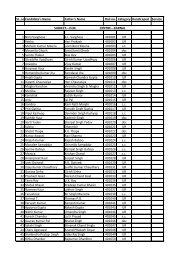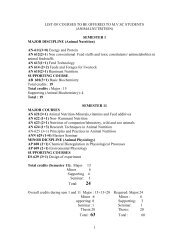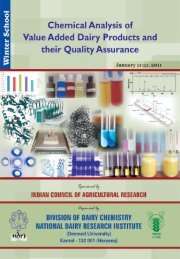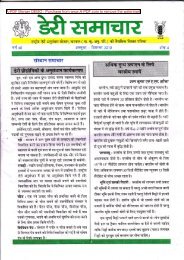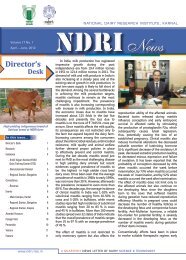ANIMAL BIOTECHNOLOGY Course Structure – at a Glance for M.Sc ...
ANIMAL BIOTECHNOLOGY Course Structure – at a Glance for M.Sc ...
ANIMAL BIOTECHNOLOGY Course Structure – at a Glance for M.Sc ...
Create successful ePaper yourself
Turn your PDF publications into a flip-book with our unique Google optimized e-Paper software.
<strong>ANIMAL</strong> <strong>BIOTECHNOLOGY</strong><br />
<strong>Course</strong> <strong>Structure</strong> <strong>–</strong> <strong>at</strong> a <strong>Glance</strong> <strong>for</strong> M.<strong>Sc</strong>./M.V.<strong>Sc</strong>.<br />
CODE COURSE TITLE CREDITS<br />
First semester<br />
BT 611 FUNDAMENTALS OF CELL & MOLECULAR BIOLOGY 3+0<br />
BT 612 <strong>ANIMAL</strong> CELL CULTURE: PRINCIPLES &<br />
2+1<br />
APPLICATIONS<br />
BT 613 IMMUNOLOGY APPLIED TO <strong>BIOTECHNOLOGY</strong> 2+1<br />
BT 614 REPRODUCTIVE <strong>BIOTECHNOLOGY</strong> 2+1<br />
Second semester<br />
BT 621 APPLIED MOLECULAR BIOLOGY 2+1<br />
BT 622 MOLECULAR DIAGNOSTICS 1+2<br />
BT 623 <strong>ANIMAL</strong> GENOMICS 2+1<br />
BT 624 TECHNIQUES IN MOLECULAR BIOLOGY & GENETIC 0+3<br />
ENGINEERING<br />
BT 629 MASTER’S SEMINAR 1+0<br />
Third and fouth semester<br />
BT 639 MASTER’S RESEARCH 20<br />
<strong>Course</strong> <strong>Structure</strong> <strong>for</strong> Ph.D.<br />
CODE COURSE TITLE CREDITS<br />
First semester<br />
BT 711 GENE CLONING AND EXPRESSION 3+0<br />
BT 712 FUNCTIONAL GENOMICS & PROTEOMICS 3+0<br />
BT 713 ADVANCES IN REPRODUCTIVE <strong>BIOTECHNOLOGY</strong> 3+0<br />
BT 719 DOCTORAL SEMINAR I 1+0<br />
Second semester<br />
BT 721 TRENDS IN VACCINOLOGY 3+0<br />
BT 722 ADVANCES IN <strong>ANIMAL</strong> CELL CULTURE 3+0<br />
BT 729 DOCTORAL SEMINAR II 1+0<br />
Next four semesters<br />
BT 739 DOCTORAL RESEARCH 45<br />
Minor Subjects to be chosen from following disciplines:<br />
1. Animal Biochemistry<br />
2. Animal physiology<br />
3. Animal Genetics and Breeding<br />
1
<strong>Course</strong> Contents<br />
<strong>ANIMAL</strong> <strong>BIOTECHNOLOGY</strong><br />
First Semester M.<strong>Sc</strong>./ M. V. <strong>Sc</strong>.<br />
BT 611 FUNDAMENTALS OF CELL & MOLECULAR BIOLOGY 3+0<br />
Objective: Molecular structure and functions of cells and molecules such as DNA, RNA<br />
and proteins.<br />
Theory<br />
UNIT I<br />
Evolution of cells, Introduction to molecular interactions, thermodynamics, and<br />
equilibrium in molecular recognition and biological functions. Cellular compartments<br />
and intercellular sorting of proteins: endoplasmic reticulum, lysosome, peroxisomes,<br />
synthesis and sorting of proteins (lysosomal proteins, membrane proteins, secretary<br />
proteins, lipoproteins, glycolipids. Lipid synthesis and transport.<br />
UNIT II<br />
Cell signaling: Endocrine, exocrine and synaptic signalling molecules, surface and<br />
intracellular receptors, G proteins and gener<strong>at</strong>ion of secondary messengers, mode of<br />
action of cAMP and Ca++ calmodulin, target cell adapt<strong>at</strong>ion. Cell growth and divisions:<br />
Cell cycle, cell division controls and trans<strong>for</strong>m<strong>at</strong>ion, growth factors, genes <strong>for</strong> social<br />
control of cell division, mechanism of cell division, cell adhesion, cell junctions and the<br />
extra cellular m<strong>at</strong>rix, growth, development and differenti<strong>at</strong>ion.<br />
UNIT III<br />
History of molecular biology, nucleic acid as hereditary m<strong>at</strong>erial, structure of DNA,<br />
chrom<strong>at</strong>in, rRNA, tRNA and mRNA, proteins. DNA replic<strong>at</strong>ion, transcription, transl<strong>at</strong>ion,<br />
genetic code, operon, positive and neg<strong>at</strong>ive control of gene expression.<br />
UNIT IV<br />
Molecular mechanism of mut<strong>at</strong>ion. Molecular organiz<strong>at</strong>ion of cell, structure of genomes.<br />
RNA processing and altern<strong>at</strong>ive splicing and molecular evolution, RNAi and applic<strong>at</strong>ion.<br />
Suggested Readings<br />
Lewin B. 2008. Gene IX. Jones & Bartlett.<br />
Primrose SB. 2001. Molecular Biotechnology. Panima.<br />
Twyman RM. 2003. Advanced Molecular Biology. Bios <strong>Sc</strong>ientific.<br />
BT 612 <strong>ANIMAL</strong> CELL CULTURE: PRINCIPLES AND APPLICATIONS 2+1<br />
Objective: Understanding the principles of animal cell culture and its applic<strong>at</strong>ion.<br />
Theory<br />
UNIT I<br />
Introduction, importance, history of cell culture development, different tissue culture<br />
techniques including primary and secondary culture, continuous cell lines, suspension<br />
culture, organ culture, hybridoma technology, culture of lymphocyte, oviductal, epithelial<br />
cell culture, stem cell and iPS cells.<br />
UNIT II<br />
Different type of cell culture media, growth supplements, serum free media, balanced<br />
salt solution, other cell culture reagents, culture of different tissues and its applic<strong>at</strong>ion.<br />
UNIT III<br />
2
Behavior of cells in culture, division, their growth p<strong>at</strong>tern, metabolism of estim<strong>at</strong>ion of cell<br />
number. <strong>Sc</strong>aling up the cell culture to large scale/industrial level production.<br />
UNIT IV<br />
Development of cell lines, characteriz<strong>at</strong>ion and maintenance of cell lines,<br />
cryopreserv<strong>at</strong>ion, common cell culture contaminants. Culture of cells <strong>for</strong> production of<br />
various biologicals.<br />
Practical<br />
i. Packing and steriliz<strong>at</strong>ion of glass and plastic wares <strong>for</strong> cell culture.<br />
ii. Prepar<strong>at</strong>ion of reagents and media <strong>for</strong> cell culture.<br />
iii. Primary culture of oviductal, epithelial and fibroblast cell.<br />
iv. Cultiv<strong>at</strong>ion of continuous cell lines.<br />
v. Quantific<strong>at</strong>ion of cells by trypan blue exclusion dye.<br />
vi. Isol<strong>at</strong>ion and cultiv<strong>at</strong>ion of lymphocytes<br />
vii. Study of effect of toxic chemicals on cultured mammalian cells<br />
viii. Suspension culture technique<br />
ix. Cryopreserv<strong>at</strong>ion of primary cultures and cell lines.<br />
Suggested Readings<br />
Freshney RI. 2005. Culture of Animal Cells. Wiley Liss.<br />
Portner R. 2007. Animal Cell Biotechnology. Humana Press.<br />
BT 613 IMMUNOLOGY APPLIED TO <strong>BIOTECHNOLOGY</strong> 2+1<br />
Objective: Understanding the applic<strong>at</strong>ion of immunological techniques in biotechnology.<br />
Theory<br />
UNIT I<br />
Introduction, principles of immunology, immune system, immune response, major<br />
histocomp<strong>at</strong>ibility complex, antigen, antibody, immunoglobulin diversity.<br />
UNIT II<br />
Applic<strong>at</strong>ion of antibodies in purific<strong>at</strong>ion, immunoblotting, expression of recombinant<br />
proteins and detection in different expression systems, industrial production of cytokines<br />
and interferon, expression of immunoglobulin genes in plants and production of<br />
antibodies.<br />
UNIT III<br />
Introduction to newer vaccine approaches namely sub-unit vaccines, synthetic vaccines,<br />
DNA vaccines, virus like particles, recombinant vaccines, edible vaccines, Nano<br />
particles in vaccine delivery systems, etc.<br />
UNIT IV<br />
Som<strong>at</strong>ic cell hybridiz<strong>at</strong>ion, hybridoma technology, commercial production of antibodies<br />
using monoclonal antibodies.<br />
Practical<br />
i. Immunodiffusion.<br />
ii. Immunoelectrophoresis.<br />
iii. Fluorescent antibody test.<br />
iv. Enzyme immunoassays including ELISA.<br />
v. Immunoblotting.<br />
vi. Affinity chrom<strong>at</strong>ography,<br />
vii. Bioin<strong>for</strong>m<strong>at</strong>ics tools <strong>for</strong> immunological research.<br />
viii. Cultiv<strong>at</strong>ion of normal lymphocytes and myeloma cell line.<br />
3
ix. Som<strong>at</strong>ic cell hybridiz<strong>at</strong>ion and production of hybridoma.<br />
x. <strong>Sc</strong>reening of hybrids <strong>for</strong> production of monoclonal antibodies.<br />
Suggested Readings<br />
Kindt TJ, Goldsby RA & Osbrne BA. 2007. Kuby Immunology.<br />
WH Freeman. Male D, Brostoff J, Roth DB & Roitt I. 2006. Immunology. Elsevier.<br />
Spinger TA. 1985. Hybridoma Technology in Biosciences and Medicine.<br />
Plenum Press.<br />
BT 614 REPRODUCTIVE <strong>BIOTECHNOLOGY</strong> 2+1<br />
Objective: Understanding in-vitro reproductive techniques <strong>for</strong> ovum and embryo<br />
manipul<strong>at</strong>ion.<br />
Theory<br />
UNIT I<br />
History, importance of assisted reproductive biotechnology in human and animal,<br />
endocrine basis of reproduction, endocrine therapeutics. Reproductive ultrasonography<br />
and its applic<strong>at</strong>ion in OPU and ETT.<br />
UNIT II<br />
Synchroniz<strong>at</strong>ion, Superovul<strong>at</strong>ion and embryo transfer technology, in vitro embryo<br />
production and micromanipul<strong>at</strong>ion of embryos.<br />
UNIT III<br />
Different methods of gene transfer, sperm and embryo sexing, transgenesis, its<br />
applic<strong>at</strong>ion and regul<strong>at</strong>ory issue, production of transgenic livestock.<br />
UNIT III<br />
Cloning of domestic animals. Conserv<strong>at</strong>ion of endangered species. Production and<br />
characteriz<strong>at</strong>ion of embryonic stem cells. Cryopreserv<strong>at</strong>ion of oocytes and embryos.<br />
Practical<br />
i. Synchroniz<strong>at</strong>ion and superovul<strong>at</strong>ion protocols.<br />
ii. Collection of embryos using non-surgical procedures.<br />
iii. Transferring embryos using non- surgical procedures.<br />
iv. Oocyte/Embryo freezing protocols.<br />
v. Oocyte collection and evalu<strong>at</strong>ion from slaughterhouse ovaries.<br />
vi. In vitro fertiliz<strong>at</strong>ion protocols.<br />
vii. Micromanipul<strong>at</strong>ion of early embryos.<br />
viii. Monitoring reproductive organ using ultrasonography<br />
Suggested Readings<br />
Ball PJH & Peter AR. 2004. Reproduction in C<strong>at</strong>tle. Blackwell.<br />
Gordon I. 2003. Labor<strong>at</strong>ory Production of C<strong>at</strong>tle Embryos. CABI.<br />
Gordon I. 2005. Reproductive Techniques in Farm Animals. CABI.<br />
4
Second Semester M.<strong>Sc</strong>./ M. V. <strong>Sc</strong>.<br />
BT 621 APPLIED MOLECULAR BIOLOGY 2+1<br />
Objective: Understanding the principle and applic<strong>at</strong>ion of recombinant DNA in<br />
biotechnology.<br />
Theory<br />
UNIT I<br />
Enzymes used in molecular biology and recombinant DNA research, important enzymes<br />
such as RNA replicase, reverse transcriptase, ligase, polymerase, ribozyme, restrictions<br />
etc., cloning and expression vectors: plasmid, Lamda (λ), Cosmid, M13, phagmid and<br />
viral vector <strong>for</strong> animal cells, construction of gene libraries, gene identific<strong>at</strong>ion, gene<br />
mapping and DNA structure analysis.<br />
UNIT II<br />
Methods of DNA sequencing; synthesis of complementary DNA, cDNA library<br />
identific<strong>at</strong>ion and enrichment of recombinant clones, synthetic chromosomes BAC and<br />
YAC.<br />
UNIT III<br />
Methods <strong>for</strong> transfer of cloned DNA, analysis and expression of recombinant DNA, site<br />
directed DNA alter<strong>at</strong>ions and gene manipul<strong>at</strong>ions, cloning in bacteria, yeast and animal<br />
cells.<br />
UNIT IV<br />
Applic<strong>at</strong>ion of genetic engineering to veterinary and medical sciences <strong>for</strong> production of<br />
high value and industrial products, Biohazard and safety aspects in genetic engineering.<br />
Practical<br />
i. Extraction of DNA and RNA.<br />
ii. Polyacrylamide gel electrophoresis (PAGE).<br />
iii. Agarose gel electrophoresis.<br />
iv. Restriction endonuclease analysis of DNA.<br />
v. Isol<strong>at</strong>ion and purific<strong>at</strong>ion of plasmid.<br />
vi. Polymerase chain reaction.<br />
vii. Cloning of gene.<br />
viii. Expression of cloned gene.<br />
ix. Purific<strong>at</strong>ion of recombinant protein.<br />
x. Blotting<br />
xi. RFLP<br />
xii. RAPD.<br />
Suggested Readings<br />
Kun LY. 2006. Microbial Biotechnology. World <strong>Sc</strong>ientific.<br />
Sambrook J & Russel DW. 2001. Molecular Cloning: a Labor<strong>at</strong>ory<br />
Manual. Cold Spring Harbour Lab. Press.<br />
Twyman RM. 2003. Advanced Molecular Biology. Bios <strong>Sc</strong>ientific.<br />
5
BT 622 MOLECULAR DIAGNOSTICS 1+2<br />
Objective: Understanding the molecular techniques involved in diagnosis of diseases.<br />
Theory<br />
UNIT I<br />
Introduction, importance and historical perspective of development of molecular<br />
diagnostic technology, concept of development of group specific and strain specific<br />
nucleic acid based diagnostics, basis <strong>for</strong> selection of gene/nucleotide sequence of<br />
p<strong>at</strong>hogenic organism to target <strong>for</strong> detection.<br />
UNIT II<br />
Applic<strong>at</strong>ion of restriction endonuclease analysis <strong>for</strong> identific<strong>at</strong>ion of p<strong>at</strong>hogens, principle<br />
of development of p<strong>at</strong>hogen specific DNA probes, Southern and Northern hybridiz<strong>at</strong>ion.<br />
UNIT III<br />
Theoretical background of development of PCR and Real time PCR and its vari<strong>at</strong>ions,<br />
applic<strong>at</strong>ion of PCR <strong>for</strong> diagnosis of infectious diseases of animals and poultry, nucleic<br />
acid sequence based diagnostics.<br />
UNIT IV<br />
Advancements in diagnostic technology including DNA array technology, biosensors and<br />
nanotechnology. OIE guidelines in development of diagnostics.<br />
Practical<br />
i. Prepar<strong>at</strong>ions of buffers and reagents.<br />
ii. Extraction of nucleic acids from bacteria and clinical specimens.<br />
iii. Restriction endonuclease digestion and analysis in agarose electrophoresis.<br />
iv. Development of animal p<strong>at</strong>hogen specific nucleic acid probes.<br />
v. Southern blotting <strong>for</strong> detection of p<strong>at</strong>hogens.<br />
vi. Polymerase chain reaction <strong>for</strong> detection of p<strong>at</strong>hogens in blood and other animal<br />
tissues.<br />
vii. RT-PCR <strong>for</strong> detection.<br />
viii. Real time PCR <strong>for</strong> detection of p<strong>at</strong>hogens in semen and other animal tissues.<br />
ix. DNA fingerprinting <strong>for</strong> identific<strong>at</strong>ion of animal species.<br />
x. PCR based detection of me<strong>at</strong> adulter<strong>at</strong>ion in processed and unprocessed me<strong>at</strong>s.<br />
xi. PCR based detection of potential p<strong>at</strong>hogens in milk, eggs and me<strong>at</strong>.<br />
Suggested Readings<br />
Elles R & Mount<strong>for</strong>d R. 2004. Molecular Diagnosis of Genetic Disease. Humana Press.<br />
Rao JR, Fleming CC & Moore JE. 2006. Molecular Diagnostics. Horizon Bioscience.<br />
6
BT 623 <strong>ANIMAL</strong> GENOMICS 2+1<br />
Objective: Understanding structural, functional and compar<strong>at</strong>ive genomics of farm<br />
animals and its applic<strong>at</strong>ion <strong>for</strong> livestock improvement.<br />
Theory<br />
UNIT I<br />
Historical perspective, genome organiz<strong>at</strong>ion in eukaryotes, s<strong>at</strong>ellite DNA including mini<br />
and micros<strong>at</strong>ellites and their various families, long and short interspersed nucleotide<br />
elements, DNA markers- RAPD, STR, SSCP, RFLP, DNA fingerprinting, SNP, EST etc.<br />
UNIT II<br />
Importance of gene mapping in livestock, methods and techniques used <strong>for</strong> gene<br />
mapping, physical mapping, linkage analysis, cytogenetic techniques, FISH technique in<br />
gene mapping, som<strong>at</strong>ic cell hybridiz<strong>at</strong>ion, radi<strong>at</strong>ion hybrid maps, in-situ hybridiz<strong>at</strong>ion,<br />
compar<strong>at</strong>ive gene mapping.<br />
UNIT III<br />
Genetic distance analysis, breed characteriz<strong>at</strong>ion on the basis of DNA markers, genetic<br />
markers <strong>for</strong> quantit<strong>at</strong>ive traits loci, marker assisted selection <strong>for</strong> incorpor<strong>at</strong>ion of<br />
desirable traits DNA markers with economic traits, restriction fragment length<br />
polymorphism (RFLP) of different structural genes.<br />
UNIT IV<br />
Current st<strong>at</strong>us of gene maps of livestock, MHC and its relevance to disease resistance<br />
and immune response, genes influencing production traits, mitochondrial DNA of farm<br />
animals, evolutionary significance, applic<strong>at</strong>ions of genome analysis of animals in<br />
breeding.<br />
Practical<br />
i. Chromosome prepar<strong>at</strong>ion (normal karyotyping, different types of banding) in farm<br />
animals.<br />
ii. Isol<strong>at</strong>ion and purific<strong>at</strong>ion of animal genomic DNA from blood lymphocytes.<br />
iii. Analysis of DNA by agarose or polyacrylamide gel electrophoresis.<br />
iv. Checking the quality and quantity of genomic DNA.<br />
v. Restriction digestion and analysis.<br />
vi. Southern hybridiz<strong>at</strong>ion<br />
vii. DNA fingerprinting.<br />
viii. Techniques <strong>for</strong> revealing polymorphism-DNA fingerprinting, RFLP, SSCP, AFLP,<br />
STRP etc.<br />
ix. Genomic DNA cloning or cDNA cloning.<br />
x. Differenti<strong>at</strong>ion of tissues of different species by mitochondrial genome analysis.<br />
Suggested Readings<br />
Gibson G & Muse SV. 2004. A Primer of Genome <strong>Sc</strong>ience. Sinauer Associ<strong>at</strong>es.<br />
Primrose SB & Twyman RM. 2007. Principles of Genome Analysis and Genomics.<br />
Blackwell.<br />
Sensen CW. 2005. Handbook of Genome Research. Vols. I, II. Wiley- CVH.<br />
7
BT 624 TECHNIQUES IN MOLECULAR BIOLOGY AND GENETIC ENGINEERING<br />
0+3<br />
Objective: To provide comprehensive hands-on training on techniques of molecular<br />
biology and genetic engineering.<br />
Practical<br />
UNIT I<br />
Isol<strong>at</strong>ion of bacterial plasmids and chromosomal DNA. Isol<strong>at</strong>ion of DNA from mammalian<br />
cells. Isol<strong>at</strong>ion of mRNA/RNA. Quantit<strong>at</strong>ion of nucleic<br />
acids.<br />
UNIT II<br />
Plasmid minprep; Restriction endonuclease digestion of plasmid and chromosomal DNA.<br />
Agarose gel electrophoresis of RE digested DNA; Isol<strong>at</strong>ion of DNA; cDNA synthesis<br />
UNIT III<br />
Polymerase Chain Reaction using random primers as well as specific primers. Diiferent<br />
types of PCR, Real time polymerase chain reaction<br />
UNIT IV<br />
Cloning of DNA into plasmid vectors. DNA lig<strong>at</strong>ion and trans<strong>for</strong>m<strong>at</strong>ion; Confirm<strong>at</strong>ion of<br />
insert by RE digestion and PCR; Synthesis of nucleic acid probes; Nucleic acid<br />
hybridiz<strong>at</strong>ion<br />
Suggested Readings<br />
Kun LY. 2006. Microbial Biotechnology. World <strong>Sc</strong>ientific.<br />
Sambrook J & Russel DW. 2001. Molecular Cloning: a Labor<strong>at</strong>ory<br />
Manual. Cold Spring Harbour Lab. Press.<br />
Twyman RM. 2003. Advanced Molecular Biology. Bios <strong>Sc</strong>ientific.<br />
8
<strong>ANIMAL</strong> <strong>BIOTECHNOLOGY</strong><br />
First Semester Ph. D. Syllabuses<br />
BT 711 GENE CLONING AND EXPRESSION 3+0<br />
Objective<br />
Understanding the concept of gene cloning and expression.<br />
Theory<br />
UNIT I<br />
Cloning vectors- plasmids, phages, cosmids, BAC, YAC, expression vectors- viral,<br />
baculo and yeast vectors, shuttle vectors<br />
UNIT II<br />
Restriction, lig<strong>at</strong>ion, trans<strong>for</strong>m<strong>at</strong>ion and recombinant selection methods, construction of<br />
genomic and cDNA library, construction of full length cDNA.<br />
UNIT III<br />
Construction and screening of genomic and cDNA library <strong>–</strong> direct cDNA selection,<br />
subtracted cDNA library, RT-PCR etc. directional cloning, in frame cloning, ligase<br />
independent cloning. DNA shuffling. R<strong>at</strong>ional designing of next gener<strong>at</strong>ion<br />
recombinant proteins with improved functionality/ novel utility: Enzyme engineering,<br />
antibody engineering etc., Protein engineering tools <strong>–</strong> site directed mutagenesis<br />
UNIT IV<br />
Expression of genes, prokaryotic and eukaryotic expression, identific<strong>at</strong>ion and<br />
purific<strong>at</strong>ion of expressed proteins.<br />
Suggested Readings<br />
Ausubel FM, Brent R, Kingston RE, Moore DD, Seidman JG, Smith JA &<br />
Struhl K. 2002. Short Protocols in Molecular Biology. Wiley.<br />
BT 712 FUNCTIONAL GENOMICS AND PROTEOMICS 3+0<br />
Objective: Understanding gene expression <strong>at</strong> different conditions/organs.<br />
Theory<br />
UNIT I<br />
Transcriptome and different methods to study gene expression, single gene analysis,<br />
northern blots, quantit<strong>at</strong>ive PCR, SAGE, MPSS and Microarray.<br />
UNIT II<br />
Introduction to basic micrroarray technology, Design of experiments, Types of<br />
microarray, nanoarray, Customised microarray design, Image processing and<br />
quantific<strong>at</strong>ion, Normaliz<strong>at</strong>ion and filtering, Explor<strong>at</strong>ory st<strong>at</strong>istical analysis, gene<br />
expression d<strong>at</strong>abases.<br />
UNIT III<br />
SAGE and Microbeads, massive parallel sign<strong>at</strong>ure sequencing, Microbial transcriptome.<br />
Role of functional genomics to study cancer and various clinical applic<strong>at</strong>ions,<br />
Development, physiology, and behavior, evolutionary and ecology.<br />
UNIT IV<br />
Proteomics technology, identific<strong>at</strong>ion and analysis of proteins by 2D analysis, mass<br />
spectrophotometery, NMR and X-ray crystallography, MALDI-TOF, Differential display<br />
proteomics, Protein -protein interaction, yeast two hybrid system and phage display.<br />
9
Suggested Readings<br />
Gibson G & Muse SV. 2004. A Primer of Genome <strong>Sc</strong>ience. Sinauer Associ<strong>at</strong>es.<br />
Primrose SB & Twyman RM. 2007. Principles of Genome Analysis and Genomics.<br />
Blackwell.<br />
Sensen CW. 2005. Handbook of Genome Research. Vols. I, II Wiley- CVH.<br />
BT 713 ADVANCES IN REPRODUCTIVE <strong>BIOTECHNOLOGY</strong> 3+0<br />
Objective<br />
Understanding the new developments in reproductive technology.<br />
Theory<br />
UNIT I<br />
Reproductive cloning, som<strong>at</strong>ic cell nuclear transfer. Applic<strong>at</strong>ion of transgenic animal<br />
production.<br />
UNIT II<br />
Folliculogenesis and immunomodul<strong>at</strong>ion assisted reproduction. Recent advances in in<br />
vitro embryo production and gametes cryopreserv<strong>at</strong>ion<br />
UNIT III<br />
Introduction to stem cells of different types. Production and characteriz<strong>at</strong>ion of<br />
embryonic and adult stem cells and iPS cells, gene targeting to stem cells.<br />
UNIT IV<br />
Stem cell and iPS cell therapeutics, social, ethical religious and regul<strong>at</strong>ory issues.<br />
Embryo micromanipul<strong>at</strong>ion, Microinjection, Intra-cytoplasmic sperm injection.<br />
Suggested Readings<br />
Selected articles from journals.<br />
10
BT 721 TRENDS IN VACCINOLOGY 3+0<br />
Second Semester Ph. D. Syllabuses<br />
Objective<br />
Understanding the l<strong>at</strong>est developments in vaccine production technologies.<br />
Theory<br />
UNIT I<br />
Molecular approaches to development of vaccines including: recombinant peptide<br />
vaccines, vectored vaccines, DNA vaccines, genetically manipul<strong>at</strong>ed live vaccines.<br />
UNIT II<br />
Plant expression system based vaccines, idiotype and synthetic peptide based vaccines,<br />
reverse genetic approach and comput<strong>at</strong>ional vaccinology.<br />
UNIT III<br />
Immunomodul<strong>at</strong>ors including cytokines and new adjuvants, Immunomodul<strong>at</strong>ion,<br />
innov<strong>at</strong>ive methods of delivery of immunogens through liposomes, microspheres,<br />
ISCOMS, etc.<br />
UNIT IV<br />
Large scale production technology and quality control, regul<strong>at</strong>ory issues, environmental<br />
concerns with the use of recombinant vaccines.<br />
Suggested Readings<br />
Selected articles from journals.<br />
BT 722 ADVANCES IN <strong>ANIMAL</strong> CELL CULTURE 3+0<br />
Objective<br />
Understanding the l<strong>at</strong>est developments in cell culture techniques.<br />
Theory<br />
UNIT I<br />
Development of cell lines, characteriz<strong>at</strong>ion of cell lines by morphology, chromosome<br />
analysis, DNA content, enzyme activity and antigenic markers, differenti<strong>at</strong>ion.<br />
UNIT II<br />
Cultiv<strong>at</strong>ion requirements of different types of cells, flow cytometry, DNA transfer by<br />
calcium phosph<strong>at</strong>e co-precipit<strong>at</strong>ion, lipofection, electropor<strong>at</strong>ion, nucleofection and viral<br />
vectors.<br />
UNIT III<br />
Expression of recombinant proteins in mammalian cell lines. Development of<br />
trans<strong>for</strong>med cell lines, <strong>Sc</strong>aling-up of cultures <strong>at</strong> large scale production. Concept of<br />
transgenics, techniques of gene transfer, microinjection of recombinant DNA into<br />
fertilized eggs/stem cells, transfection of DNA, electropor<strong>at</strong>ion, gene transfer into<br />
cultured cells.<br />
UNIT IV<br />
Up-scaling of cells <strong>for</strong> production of vaccines, diagnostic antigens and other<br />
pharmaceutical agents, up-stream and downstream processing, cell culture fermentors.<br />
Suggested Readings<br />
Selected articles from journals.<br />
11



